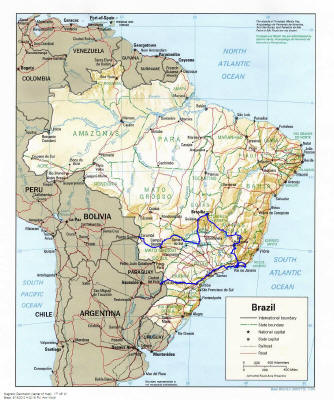The
border was an interesting exercise. We drove through and were continually told
to move on which we did. Eventually we reached Corumba,
the nearest town. No stamps, no documents, nada. Not good. First we went to the
bank to withdraw reals and have some lunch. Then we
headed back to the border and this time after driving back into
Back to the Brazilian border. This time we had our
passports stamped. Now the car. Lots
of red tape and time but no problem. It was now well after dark, we were
tired and in no mood to find a camping spot. The hotel prices staggered us but
it was a nice bed and bathroom with breakfast included.
Wednesday
23 to Friday 25 June 2010, Pantanal
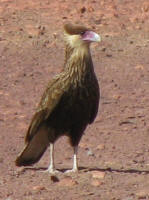
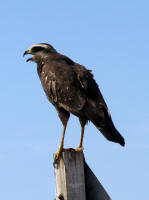
The drive
through the southern pantanal was interesting. We saw
many birds. Flocks of little yellow jobs, green jobs, birds
of prey and others. Pity we do not have a bird book to identify them
all. We also saw many capybara, the largest rodent in
the world. None of these birds were intimidated by the car, somewhat wary
though.
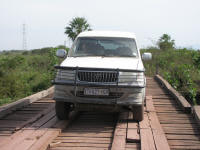
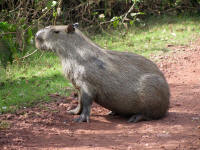
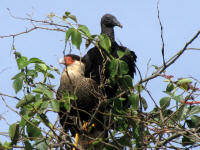
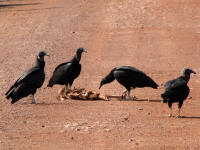
Pieter
was concerned about the amount of drinking water we carried, thinking it was
low and would not enable us to wild camp. He asked for a lovely camp site to
spend a few days working on small jobs on the equipment and perhaps to re-fix
the tyre as well. How can I provide this when I don't
even know if there is a camp site? Everything is fenced so wild camping is out
of the question. Eventually we came across a camping sign for Fazenda Sao Joao. It is a lovely place with cold showers
only but clean. They usually cater for groups but
individual campers are also welcome. There was a group there at the same time
as us, traveling from
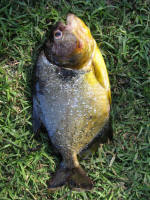
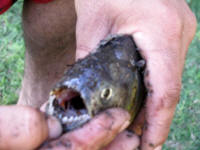
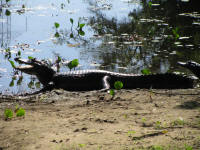
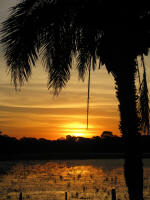
Each
evening a pair of dark blue parrots flew to a palm tree nearby and ate some of
the fruit. Lovely to watch.
The worst
was my computer. There are speed humps on the dirt road. Three in particular
are near a single house far from anyone else. They are huge and blending with
the road to become almost invisible. The first bump was the worst and we think
that is what ruined my mother board. It is very annoying. Why do they need all
these speed humps? They are to be found on the main roads as well, sometimes
without any logical reason.
Saturday
26 to Tuesday 29 June 2010,
Next stop
was
We had
noticed many vendors selling world cup paraphernalia on the way in and wondered
why. The explanation, of course, was the game which we naturally watched along
with the whole family. Every time
Wednesday
30 June 2010, Paraiso
Next stop
is Brasília to find a repair shop for the fridge. Our route took us through
large fields of sugarcane, cotton and pineapple. The fields are so large they
go on as far as the eye can see. You can almost believe that only 1% of the
population owns all the land. There is hope for individuals though as Wilma and
Gerald own their house and land.
We
followed a dirt road to a barn with no-one around and spent the night, campfire
and all.
Thursday
1 July 2010, Frutal
We missed
the turnoff we were looking for and ended up doing an extra 300 odd kilometers
to get to Brasilia.
At lunch
time we stopped for a break at a service station cafe and ended up watching
This time
we spent the night at an ex service station, in the back away from the road. There
were still hot showers. Lovely.
Friday
2 July 2010,
Another
long days drive. We have put ourselves on a tight
budget until the flats start paying again. They were high jacked by the tenants
in November. The tenants refused to pay rent, electricity or anything else. They
received an eviction order in early January but kept refusing to move. They
were only forcibly ejected in May. Now the malicious damage is being repaired
and hopefully we will have new tenants soon. Naturally the instigator asked the
others to give him the rent which he would then keep "safe". There
were over 12 properties involved, all due to the one person. The result for us
is that we cannot stay in hotels but must camp, free or otherwise. Today proved
bad. Pieter wanted to drive until we were almost out of diesel. Unfortunately
this brought us relatively close to
After
dark we eventually stopped by the side of the highway and camped under some
trees, right in a suburban area. We used the small tent which we have for
emergencies. It is small, our sleeping mats are too
long. On top of this we only hauled out 1 blanket and ended up spending a cold
cramped night. Needless to say we were up early next morning and off again
without breakfast.
Saturday
3 to Sunday 11 July, 2010,
Camping at last. The Youth Hostel allows people to camp at the back of
the property under some trees. Breakfast is included. What more could we ask!
We definitely need a break after 3 days of long driving. No, we are not as
young as we used to be.
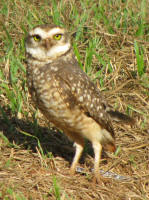
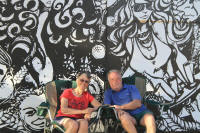
In
Later I
went looking for a bookstore, hoping to buy an LP for
Finally
after a week it was time to move on.
Monday
12 July 2010, east of Paracatu
Driving
on good tar is bliss. The weather was mild. The days are warm to hot - shorts and T-shirts are the usual dress. Nights can be cool
to cold. Long tops, pants and socks are needed. The camping place we found was
nicely grassed, close to the road but well screened by trees.
Tuesday
13 to Monday 18 July 2010,
The camp
ground was difficult to find. We had co-ordinates but they were 2 minutes out
according to our GPS. This makes a difference of several kilometers.
Also many people did not even know there was a campsite. The
tourist office was near the main square as expected and they gave us a
reasonable map of the town and an indication of where to go. It still took some
time though.
We
enjoyed listening to the 'piet me vrou'
and watching the humming birds. These are so small and fast it is amazing to
see.
I walked
into town to see the sights and get some exercise. I can assure you the hills
are steep! The attractions are interesting. Diamantina
exists because diamonds were found in the
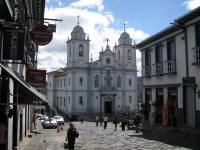
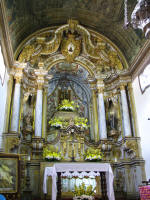
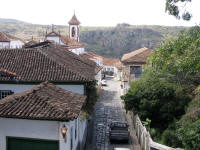
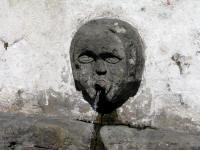
The one
thing I miss in the town is a place to sit outside and have coffee. You can
have a beer outside though which no doubt suits most people.
We asked
our host if he knew where we could get the fridge fixed. He had a friend who,
unfortunately, could not fix it. The fridge was passed on to another man who
could fix it. BUT he needed to source an integrated circuit and hoped to get
it from
Thursday
22 July 2010, Sabinopolis
By the
time we packed up it was getting late in the morning. Then since we had money
in the kitty, Pieter decided to chase up an extension to the exhaust which was
badly needed. This took more time. The scenery was hilly, good for cattle and
some vegetables. The villages are part of the Estrada
Real, each with their white and wood beam churches. Lovely
to drive through.
The
Estrada Real was developed during the 17th and 18th centuries specifically to
bring the gold from the
We had
trouble finding the road out of Serro and ended up in
Alvarado de Minas.
It was good tar so we assumed it was the main road. It was also on the Estrada
Real. It seems the Estrada Real includes dirt roads. We returned to Serro and this time found the right road. In the end we
only did 160k of the 400k I had expected.
Friday
23 to Tuesday 27 July 2010, Ouro Preto
Once
again we missed the turnoff and ended up going through
The town, started in 1711, was
set amid the western hemisphere's richest gold deposits.
It is full of tourists as there is a winter festival going on. Parking is at a
premium, usually on a slope. The town itself is very hilly. A church which is
100m away is also likely to be
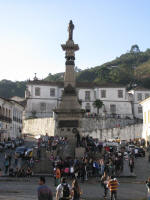
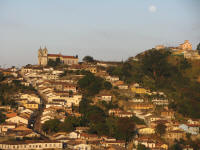
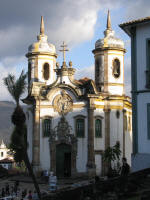
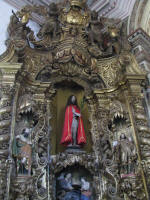
Wednesday
28 July to Monday 2 August 2010, Sao Joao del Rei
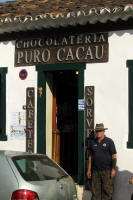
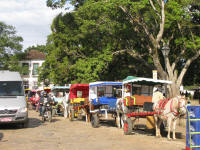
Tiradentes, which we did visit, is very touristy and therefore expensive. It is well preserved though. Personally I preferred Ouro Preto.
Tuesday
3 to Wednesday 18 August 2010,
The journey was short so we were not in a big hurry to get to Rio. This was a mistake as the roads are being upgraded and we spent quite some time waiting at road blocks. Rio of course was busy and traffic slow. It was also raining intermittently. At least we had a plan on how to find accommodation. First a youth hostel in Botafogo, then a camp site in Sao Conrade, last a camp site in Praia de Macumba, an hour from town. We were at the hostel in reasonable time even though it took about an hour to find it. It was full but they recommended another hotel just around the corner. Right! They didn't know the actual address and we could not find it. Next stop Sao Conrade. We had been told there was a campsite used mainly by surfers there. By now it was after dark and past dinner time. We combined asking for the campsite with a much needed meal. We were assured that no such campsite existed by several locals. On to Praia de Macumba - not to be confused with the drink, Macumba. There were no signs so we overshot and had to turn back. It was now very late and raining quite hard so when we found the campsite we had no option but to stay. We were surprised at how expensive the site was and said so. Needless to say we paid and set up the tent in the rain, glad to have a bed for the night. As an aside, we discovered that light bulbs are sensitive to the strength of the power supply. We had a light bulb purchased in Brazil but for some reason the campsite had 220 volt not the standard 110 volt. This destroyed the light bulb - great! Come the morning and we had a look around. The camp site looked as though it had closed for winter. There were large tents, as big as a small house permanently set up. They were covered in blue plastic and tied down very securely with straps going over the top. Naturally some had partially collapsed presenting an image of total neglect. There were very few other campers, certainly no travellers like us. The facilities were average with one hot shower in the ladies which Pieter used. We were totally disallusioned with the whole set up. This time we packed up in the rain. had a stand up breakfast, no tea or coffee, and headed back to Botafogo where we expected to find beds at the hostel. No luck, the 3 beds available had been taken by the time we arrived. Once again they mentioned Vila Carioca, down the street, right and right at the first street - slightly different directions! We couldn't find it so I returned and asked to use the interent to find some accommodation. This time the receptionist looked up google earth. Now we had an address and accurate directions! This hostel is in a cul-de-sac and has mixed dorms. We are paying the same as in the campsite - with breakfast included. We can get into town on public transport as well. Much better.
The weather did improve slowly so most of the days were warm and sunny - but not all. Some days were quite cold.
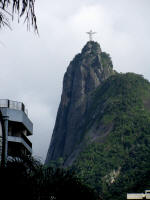
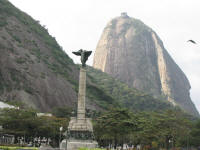
Rio is a vibrant city spread out along the shore and between the mountains, mainly cores of ancient volcanoes. There are quite a few things to see, including the inevitable churches. We went on the ferry to Niteroi across the bay, explored the Saturday antique market, walked past some of the churches, visited the modern Cathederal, walked to Sugar Loaf, drove through the Tijuca rain forest to Christ the Redeemer, attended a Hoda of Capoeira Angola and I went on a tour of a Favella. We didn't go up to either Sugar Loaf or the Redeemer, the icons of Rio - far too expensive and the views from nearby are probably just as good.
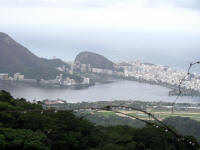
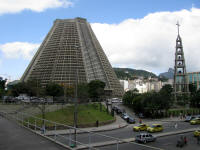
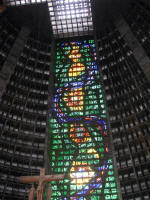
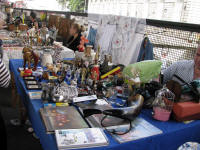
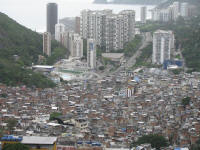
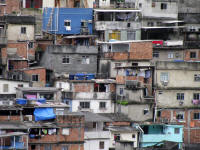
I enjoyed the tour of Favella Rocinha, the largest of the 1200 favellas in Rio. Rocinha houses about 200,000 of the 1 million people living in favellas. About 600 of the favellas are run by drug lords, including Rocinha with its gun toting bandits. There are insufficient schools and clinics for the population. Living is cheap though. A single room, probably without windows, sewerage or water goes from 300 reals. Houses can be purchased from 5,000 to 50,000 reals. Residents do not own the land so they don't pay rates; water is pumped up from municiapl sources and not paid for; electricity is stolen through illegal connections; rubbish is collected by community workers and taken to the main streets for collection. Of course if the rain washes your building away there is no compensation.
The tour started at the bottom with a moto-taxi (motor bike) ride up one of the main streets to the top. A main street is defined as one which carries vehicles. Other streets are strictly pedestrian, some times even single lane. We were told in the bus that men should not hold on to the driver. Woman, on the other hand should cling on tight as the drivers loved that. The girl in front of me had short shorts on and clung on tight. My driver continually shook his head saying Oh La La. He also ribbed the other driver. This girl had one of the slowest drivers! We then walked down through the favella, passing various sales points and 3 boys who gave a short concert. The favella is built up a hillside. The only way to expand is up. The result is narrow alleys between 3 or 4 storey buildings. Living quarters can be a small house down to a single room without windows built straight into the rocks. Just about everything can be purchased in the favella from the small shops in odd corners or larger shops in a living room.
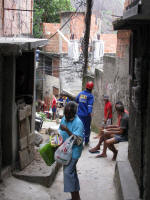
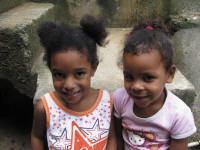
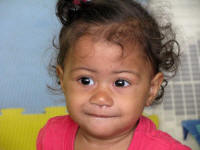
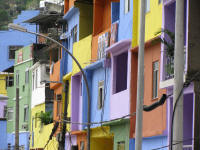
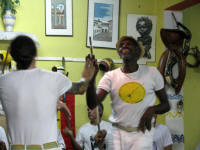
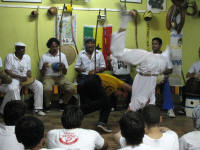 Capoeira is a form of dance which uses moves
from the martial arts. Angola is a type of capoeira. A Hoda is a 'competition'.
Several people at the hostel practise capoeira. While we were there a festival
was held. Most of the day comprised classes but at the end there was a hoda
which we attended. It was very interesting to watch. The 'dance' is accompanied
by music with a beat. The beat determines the moves a person makes. Two people
'play' each other without actually touching. They respond to each others moves.
The more experienced can come out with fast unexpected moves which can gently
topple an partner. Several moves
involve hand stands and slow catherine wheels. The
players were all very flexible with strong upper bodies.
Capoeira is a form of dance which uses moves
from the martial arts. Angola is a type of capoeira. A Hoda is a 'competition'.
Several people at the hostel practise capoeira. While we were there a festival
was held. Most of the day comprised classes but at the end there was a hoda
which we attended. It was very interesting to watch. The 'dance' is accompanied
by music with a beat. The beat determines the moves a person makes. Two people
'play' each other without actually touching. They respond to each others moves.
The more experienced can come out with fast unexpected moves which can gently
topple an partner. Several moves
involve hand stands and slow catherine wheels. The
players were all very flexible with strong upper bodies.
Thursday 19 to Sunday 22 August, Teresopolis
Leaving Rio was an absolute nightmare. We took the wrong turn near the start of our trek. Instead of going back and taking the correct turn, we continued. After all we do have our infallible GPS! Unfortunately it does not have a map of Brazil loaded and Rio has all these high, non negotiable hills. We just couldn't find the way back to the correct road. After going through several favellas and driving along some bad urban roads we eventually came upon it. How to get on? After going around in circles, literaly, for a while we asked another driver. He very kindly led us onto the highway through some back streets. On our way at last. There was one good thing about the trek - always a silver lining! - we found a shop selling exactly the right tyre to replace the one ruined in Bolivia.
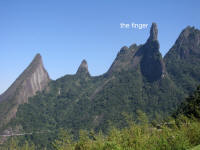
There is lovely mountain scenery in the whole area along with winding roads. Many of the mountains are bare on top, presumably they are volcanic cores. On the lower slopes there is beautiful lush growth. I love travelling through this type of scenery. The 'famous' Finger of God' is prominent and can be seen from many places in Teresopolis.
The intention was to visit Petropolis on the way to Teresopolis where there is a campground. We went a shorter route from Rio and missed it. A day trip was in order. I am very glad we went to Teresopolis the other way. Going through Petropolis would have added hours to the trip. It was not supposed to be far. The municipal boudary is quite close and we passed a sign saying Petropolis was 1K ahead. 20K later we came to the historical centre!
Petropolis is where the Imperial Court spent the summer to get away from the heat of Rio. Imperial Court? Yes, Brazil was a monarchy. From 1807 to 1822 it was ruled by the Portuguese Monarch. Dom Joao had fled from Napoleon to Brazil and ruled the Portuguese Empire from Rio. In 1822 Dom Joao's son Pedro declared independence from Portugal and named himself Emperor of Brazil. He lasted 9 years. Due to incompetence and excessive sexual exploits he was forced to abdicate in 1931 in favour of his 5 year old son Pedro ll. Pedro ll was declared an adult at 15 years of age (1841) to stop the turmoil created by the various regents. He ruled reasonably well until 1889 when he was toppled by a military coup.
The historical centre is another lovely old city - with the requisite cobblestone roads. There were lots of tourists even though it is winter. I can't imagine how crowded it will be in summer. The palace has been turned into a museum displaying furmiture, clothing and the imperial crown amoung other things. These include numerous portraits of Don Pedro ll, obviously he loved having his portrait painted and later photos taken.
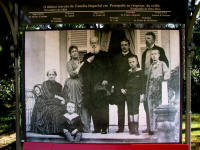
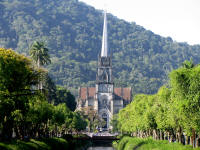
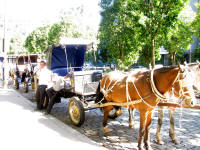
Monday 23 to Friday 27 August, Cabo Frio
The campsite was good but the nights were cold, back to the coast! The Circuito Touristico Tere-Fri goes through lush hills past fields of vegetables and resorts and hotels and more resorts and hotels. It seems half of Rio must come to this area in summer. The area also produces honey and we bought a bottle. Toast, butter and honey - delicious.
The first campsite we went to was OK but in need of some basic maintenance, like sweeping the loo. It was also windy with plenty of mosquitoes. Next day we looked at another campsite and after some negotiation on Pieter' part we arranged a discount. The CCB campsite was much better maintained and closer to the town.
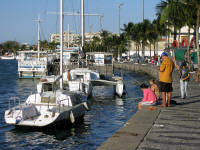
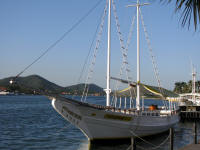 The
reason for coming here is the coastal scenery and the beaches. The harbour at
Cabo Frio is neat but the scenery is better further north at Buzios. Once again
we went for the day. It is magnificent. All white beaches nestled between rocky
headlands, hills, peninsulars, lush growth and hotels. We sat at Joao Fernandes
Beach watching the people on the beach and the waiters scurrying to move the
chairs back away from the approaching high tide. Pieter enjoyed Cachaca a potent
Brazilian drink made from sugar cane alchohol because he still had to drive and
he didn't want a large beer!
The
reason for coming here is the coastal scenery and the beaches. The harbour at
Cabo Frio is neat but the scenery is better further north at Buzios. Once again
we went for the day. It is magnificent. All white beaches nestled between rocky
headlands, hills, peninsulars, lush growth and hotels. We sat at Joao Fernandes
Beach watching the people on the beach and the waiters scurrying to move the
chairs back away from the approaching high tide. Pieter enjoyed Cachaca a potent
Brazilian drink made from sugar cane alchohol because he still had to drive and
he didn't want a large beer!
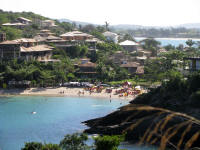
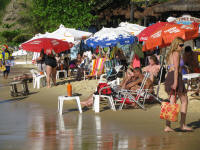
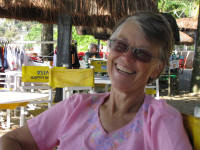
Saturday 28 August 2010, Rio de Janeiro
Just an overnight on the way to Ilha Grande where we will have to store the car, catch a ferry and find accommodation.
Sunday 29 August to Wednesday 2 September 2010, Ilha Grande
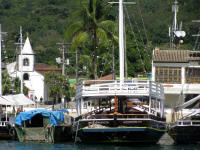 What
a lovely interlude. Cars are not allowed. You get around by foot or boat. Most
of the island is a nature reserve with paths going over the hills to various
beaches. Everything seemed to go well for us. We found a garage to park the car,
were driven to the ferry which left within a few minutes. This was the only
ferry for the day! Although you can hire a boat or go by catarmaran later. Once
we arrived we were met by a hotel tout and offered a double room for only a
little more than we expected to pay for a 9 bed dorm. Sheer luxury. I went for a
walk every day. The first day to ??? waterfall. That cured me of long walks. It
goes up and down and up a lot more and down a little, repeated several times. At
least the return was mainly downhill. In the mornings we went to the beach and
watched people arriving and leaving on the ferry and others leaving to go on
boat trips for snorkelling or swimming. In the evenings we strolled around and
enjoyed the holiday atmosphere. Blissful!
What
a lovely interlude. Cars are not allowed. You get around by foot or boat. Most
of the island is a nature reserve with paths going over the hills to various
beaches. Everything seemed to go well for us. We found a garage to park the car,
were driven to the ferry which left within a few minutes. This was the only
ferry for the day! Although you can hire a boat or go by catarmaran later. Once
we arrived we were met by a hotel tout and offered a double room for only a
little more than we expected to pay for a 9 bed dorm. Sheer luxury. I went for a
walk every day. The first day to ??? waterfall. That cured me of long walks. It
goes up and down and up a lot more and down a little, repeated several times. At
least the return was mainly downhill. In the mornings we went to the beach and
watched people arriving and leaving on the ferry and others leaving to go on
boat trips for snorkelling or swimming. In the evenings we strolled around and
enjoyed the holiday atmosphere. Blissful!
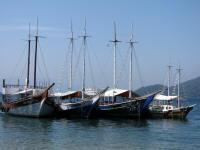
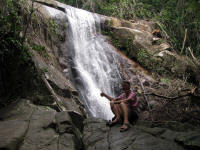
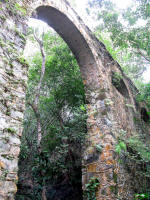
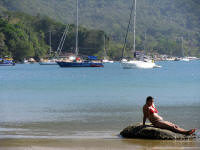
Thursday 3 to Friday 9 September 2010, Paraty
Paraty is at the end of the overland gold route (Estrada Real) until they pushed through a shorter route to Rio de Janeiro through Petropolis. From here the gold went up the coast to Rio before going to Portugal. It is well preserved and renovated, including the cobbled streets. Luckily for the cars most of the old town is pedestrian only.
The weather was lovely - for 2 days. Then the rain set in. We sat it out as to pack up in the rain is not a good option, especially as we planned to head to another coastal resort and camp again. It would have been raining there as well. It was also holiday time. Tuesday 7th was Brazilian Independence Day and Wednesday a local holiday for the Festival of Nossa Senhora Remedios. The camp ground was reasonably full for the long weekend.
Duing dry periods we walked around the old town and up to the old fort. Cake was plentiful in the afternoons. Vendors have people drawn trailers with a large glass covered cool box full of all types of delicious cakes. We tried quite a few. The rest of the time was spent reading and lazing around. This gave me time to think about the route ahead and realise we had 10 days left on our visa! Horrors! We have to move it to leave in time. We do not want to extend as it costs me money and we would not use all the available extra time. Pieter is free - lucky European. A change in plans was called for. Instead of a slow trip down the coast to Uraguay with a side trip to Iguacu Falls, we now had to head more or less directly to Iguacu.
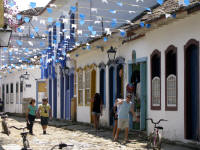
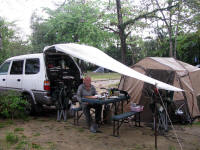
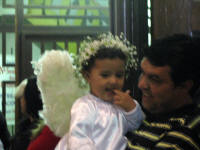
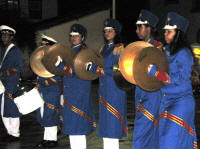
Friday 10 to Sunday 12 September 2010, Sao Paulo
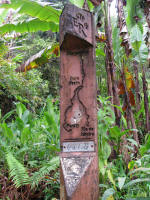
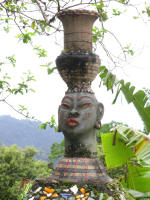 We
took the direct route to the main Rio Sao Paulo highway instead of the road
along a convoluted coast line. It was an interesting choice. The road follows
the Estrade Real winding through the hills and villages until it reaches the
Parque Nacional da Serra da Bocaina. There the tar stops and an unmaintained
dirt road takes over until you are through the park. It is a 'relatively' busy
road despite it's condition. We passed 6 cars and 6 cyclists coming down plus a
VW Beetle passed us going up. You get up really close to Atlantic Rainforest
with some spectacular views of Paraty. The gold travellers must have been very
pleased to see the town in the distance, though it
probably took them a good few days still to reach it.
We
took the direct route to the main Rio Sao Paulo highway instead of the road
along a convoluted coast line. It was an interesting choice. The road follows
the Estrade Real winding through the hills and villages until it reaches the
Parque Nacional da Serra da Bocaina. There the tar stops and an unmaintained
dirt road takes over until you are through the park. It is a 'relatively' busy
road despite it's condition. We passed 6 cars and 6 cyclists coming down plus a
VW Beetle passed us going up. You get up really close to Atlantic Rainforest
with some spectacular views of Paraty. The gold travellers must have been very
pleased to see the town in the distance, though it
probably took them a good few days still to reach it.
Something has happened to our sense of where places are. We had problems again finding the hostel. We actually went passed the street several times without realising it, all because we thought it was further on.
Sao Paulo is basically a commercial town with some attractions. We did go into town and have a look at the Catederal da Se built in 1920 and then on to the Municipal Market. This was fascinating. The produce is displayed very well in a large hall with stained glass windows. There are plenty of eateries some specialising in fruit salad and fruit juices. The downside is the part of town where it is situated. The homeless and drunks are everywhere. Shelters made out of blankets and plastic have been built under the highways. During the day it is warm but it can get cold at night and no doubt they suffer.
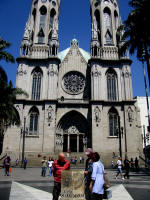
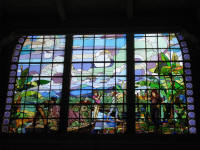
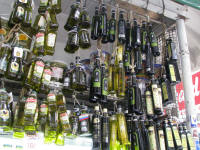
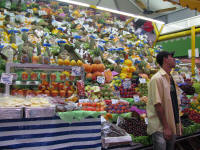
Monday 13 to Tuesday 14 September 2010, to Iguazu
I expected the trip to take 3 or 4 days. It took only 2.5 days because of the very good toll roads. The scenery consisted of hills and valleys with lots of cultivation.
Wednesday 15 to Sunday 19 September 2010, Foz do Iguacu
Which waterfall do you want to see? There are 272 of them! I actually thought we could see the whole falls from the first sight of them. Not so. These were only some of them. The largest is the Devil's Throat and that you only see towards the end of the walk. Superlatives are not enough. You have to see them for yourself. Yes they are more spectacular than Victoria Falls, something I didn't think was possible.
The Tupi-Guarani legend on how it was created is sad.
"Many years ago, Rio Iguaçu ran free with no rapids and no cataracts. The Indians who dwelt on the edges of the river believed in the great shaman M'Boi, son of the snake god Tupa. Virgins were regularly sacrificed to M'Boi. Tarobá, a young warrior of the tribe, loved a beautiful virgin called Naipu. On the day Naipu was to be sacrificed, Tarobá took Naipu and escaped in a small canoe.
M'Boy was furious with the fugitives and went into the ground as a snake. He twisted up causing landslides and a huge canyon thus forming the falls. Naipu was turned into a rock constantly battered by the water falling over the Devil's Throat. Tarobá was turned into a palm tree on the edge of abyss, destined to contemplate his loved one without ever touching her."
NB: Iguazu is the Guarani word for great water.
Some comparisons with Victoria Falls
| Iguaçu | Victoria | |
| Width | 2700m | 1708m |
| Height | 64m to 80m | 90m to 108m |
| Average volume of water | 1746 cubic meters | 1088 cubic meters |
| Highest volume recorded | 12600 cubic meters | 12800 cubic meters |
| general | U shaped, opens onto wide river, easy to see, 272 seperate falls | water falls into a high gorge. Sometimes cannot see the bottom, basically one sheet of falling water |
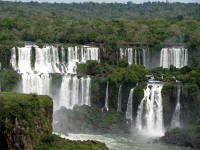
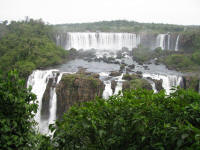
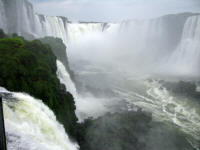
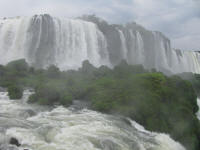
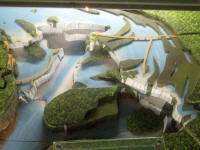
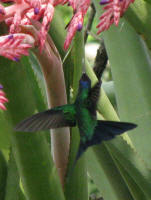
| Averages | USD |
Back to Bolivia |
Next to Argentina North to South | |
| Cost of diesel per litre | 1.14 | |||
| Hotels per night | 36.11 | |||
| Camping per night | 16.58 |
|
||
| Total | ||||
| Kilometers traveled | 10,463 | |||
| Days in country | 89 |
